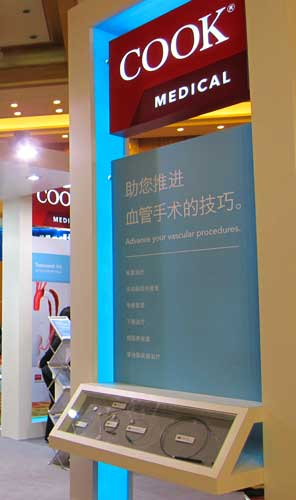The tradeshow industry has grown over the decades from holding mostly regional and national events to conducting large-scale international affairs. And whether exhibiting in a tradeshow based in the U.S. or in another nation, more exhibitors are targeting international audiences, and that means changing their graphics and messaging.
“We currently see consistent global brand architecture with localized graphics designs,” said Tim Murphy, president and CEO, AD-EX International. “Depending on regional and cultural trends, graphics may be more descriptive, have more bulleted product and service features or localized translations other than English.”

While the brand architecture might stay the same, the type of message content can vary greatly.
“For instance, in the healthcare industry, large differences can be attributed to comparable graphics from one region to the other depending on market share and positioning statements,” said Murphy. “In contrast, fashion industry graphic design does not necessarily have many differences across international events. Brand identity and large-format graphics with current imagery or trending celebrity endorsers are typically used in these instances.”
While the notion of celebrity can transcend national boundaries and cultural barriers, product and service branding efforts vary greatly as well as their success rates. True success lies in learning what works best for targeted audiences from specific nations and regions.
“It’s important exhibitors understand that while maintaining a consistent brand globally may be a primary marketing objective, they will have to resource and implement regionally based marketing campaigns through targeted copywriting and graphic design,” said Murphy. “By coordinating content with multiple teams, including internal marketing communications, agencies and local production companies, we’re able to streamline communication and maintain brand intent, ultimately resulting in cost savings.”
Much of the graphic design done in the U.S. is aimed at local events, but even local events can help define a brand on an international scale. Firms exhibiting at domestic tradeshows often times can modify their presentations for international audiences.
“Most graphic design work for U.S.-based companies is intended for domestic events,” said Murphy. “After the initial layout and positioning is decided, we’ll use the template for localized graphics. We’re able to maintain brand consistency through visual communication while still targeting the appropriate audience.”
Fortunately for U.S.-based exhibitors and firms, English has become a fairly standardized language of international business, making the task of the international exhibitor a little bit easier.
“By using this universal language, we’re able to streamline the process of deciding whether to design graphics in English versus translating into local languages,” said Murphy. “After decisions have been made, the translation from global English progresses rather quickly.”
While there is much to be done to create appropriate graphic designs for international audiences, those lessons do not have to be relearned over and over.
“We collaborate on a proprietary shared-software platform, controlling access, workflow, editing and approvals,” said Murphy. “Finished results are then exported to uniform reports and shared throughout businesses as a best practice tool and to maximize efficiency.”
Maximum efficiency means doing more than identifying best practices. Knowing and abiding by local law and cultural norms is a critical element of graphic designs for international audiences.
“Regulatory issues, both internally and externally, have huge implications when designing graphics for exhibits,” said Murphy. “For instance, within U.S. corporations, their regulatory departments will typically provide the first approval of graphic designs. Then the concepts are sent to either regional regulatory or management for final approval.
“Externally, in certain countries, we have to provide graphic design or multimedia content to proper authorities before exhibition occurs,” Murphy continued. “These many layers, whether on the corporate or government level, across all products, services and industries, have many legal ramifications that affect timelines and provide approval challenges.”
Proper attention to legal and cultural differences combined with internal efficiencies can help exhibitors boost their success rates among international audiences, whether exhibiting at home or abroad. Cincinnati-based AD-EX International provides design, fabrication and logistics services for domestic and international tradeshows and participants.































